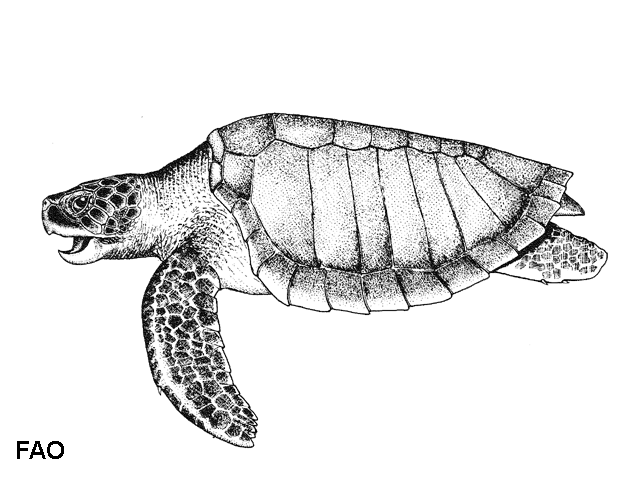| Cheloniidae (sea turtles) |
| 76 cm CL (male/unsexed); max.weight: 43 kg |
|
benthopelagic; marine; depth range 0 - 200 m |
| Indo-Pacific and the Atlantic Ocean. |
|
The olive ridley turtle has a slightly deeper body than the Kemp’s ridley. In adults; carapace nearly round; upturned on the lateral margins; flat on top; its width 90 percent of its length (Straight Curved Length (SCL)). Head: subtriangular; moderate-sized; averaging 22.4 percent of straight carapace length (SCL). Hatchlings: relatively bigger heads (39 percent SCL); longer carapaces (width 78 percent SCL); flippers comparatively bigger than in adults. In 3-year old juveniles: the carapace width, 93 percent of SCL; head length, 26 percent of SCL. Scales and scutes: same configuration as in the Kemp’s ridley; but the lateral scutes are often more than five pairs; the first pair is always in touch with the precentral scute. Also has openings of the Rathke’s glands on the plastral bridges; through a pore on the rear part of each inframarginal scute Fore flippers with 1 or 2 visible claws on the anterior border; sometimes another small claw in the distal part; rear flippers also with 2 claws. Males: larger more strongly curved claws; as well as a longer tail. Color: adults, plain olive-grey above; creamy or whitish; with pale grey margins underneath. Newborn hatchlings: when wet; almost completely black; sometimes with greenish sides; in general, become dark grey after drying. With growth; they change to grey dorsally and white underneath. |
| This species is the most abundant sea turtle in the world. Frequently neritic, usually migrates along the continental shelves and feeds in shallow waters (Ref. 1397) but also dives deeper than 150 m (Ref. 78527). Shallow coastal waters; open sea forming schools (Ref. 417). Habitat is a warm vertically stratified water with deep thermocline (Ref. 78527). Observed to be basking on sand beaches (Ref. 1397). Nesting patterns range from solitary to small groups to arribadas (Ref. 97534). Little information exists on the feeding behavior of post-hatchlings and juveniles in pelagic waters, but they are most likely exclusively carnivorous, consuming, for instance, invertebrates and fish eggs. Older juveniles and adults feed on a wide variety of benthic organisms (Ref. 122680). |
|
Vulnerable (VU); Date assessed: 30 June 2008 (A2bd) Ref. 123251)
|
|
|
Source and more info: www.sealifebase.org. For personal, classroom, and other internal use only. Not for publication.

